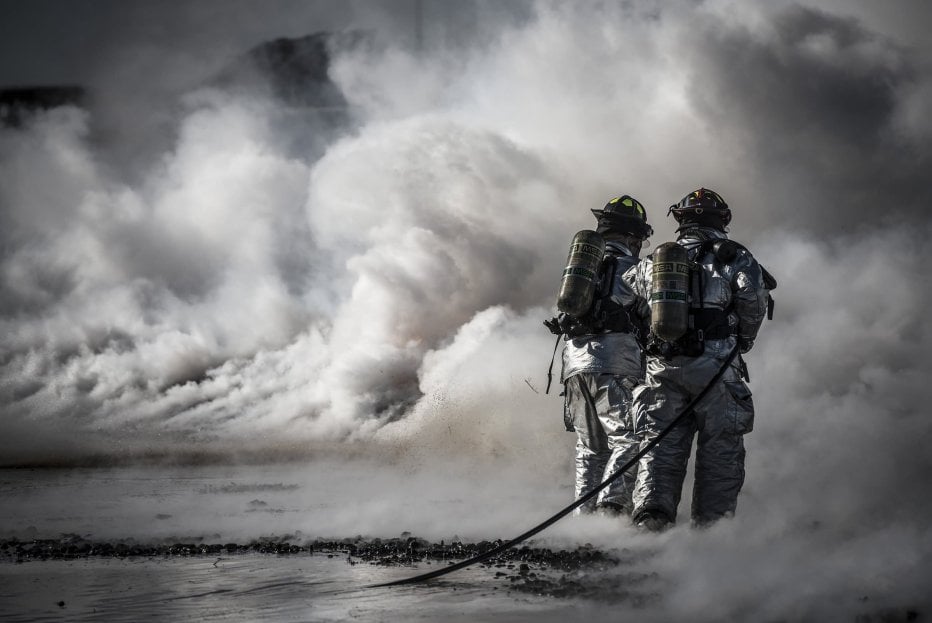Strategies for Reducing Cancer Risk in Firefighters

By Ryan Provencher and Sunjya Schweig, MD
January is Firefighter Cancer Awareness Month and it’s important to acknowledge that occupational cancer is the leading cause of line-of-duty deaths in the fire service. The IAFF reports that more than 75% of the names added to the Fallen FireFighter Memorial Wall in 2019 were members who died from occupational cancer.
The fire service has made significant progress in implementing on the job strategies to help reduce the risk of cancer, such as source capture for diesel exhaust, issuing two sets of turnout gear, the consistent wearing of SCBA, first in first out procedures, proactive on-scene decontamination, clean cab initiatives, washing gear and showering after exposures to toxins, and more.
These improvements in our work environment are critical, however, it is also important for each of us to consider how we can be proactive away from work to further reduce our risk for cancer.
Here are six key lifestyle changes that can help you live an anti-cancer life:
Exercise and Move Regularly
A study from the American Cancer Society showed that exercise can help lower the risk of 13 different types of cancer. Exercise can help reduce the risk of cancer by decreasing inflammation, strengthening the immune system, balancing hormones, regulating insulin levels, and helping to prevent obesity, which is a risk factor for many cancers. Regular physical activity also promotes lymphatic drainage, detoxification, stress resilience, and increases the production of important cancer-fighting antioxidants such as glutathione.
While regular physical activity is clearly important, it is also key to avoid overtraining as this can alter your microbiota, increase inflammation, elevate stress hormones, deplete glutathione, and weaken the immune system. Monitoring morning resting heart rate and overnight heart rate variability (HRV) can be helpful for monitoring recovery, readiness for exercise, and determining your exercise intensity. You can use wearable technology such as an Oura ring, and phone apps such as HRV4Training or Elite HRV to monitor both resting heart rate and HRV. If you note a decrease in HRV or your resting HR trending up, make sure to rest that day.
Consume a Minimally Processed Diet
Diets high in added sugars, inflammatory fats, processed foods, environmental toxins, and deficient in critical cancer-protective nutrients can contribute to cancer cell growth by increasing inflammation, disrupting your gut, reducing immune system function, and more. Eating a whole-foods, plant-based diet with real, unprocessed, or minimally processed foods is the foundation of an anti-cancer lifestyle. Plant-based foods are high in antioxidants which help to boost your immune system and protect against cancer. Fruits and vegetables contain more than 25,000 cancer-fighting nutrients called phytochemicals that work synergistically to protect your body. More than 200 population studies have shown that people who eat colorful fruits and vegetables are less likely to get cancer.
Improve Gut Health
Health and disease begin in the gut. An estimated 39 trillion microbial cells, including bacteria, viruses, and fungi, live in and on us and you can find anywhere between 500 to 1,000 different species of bacteria in the gut alone. Seventy to eighty percent of our immune system is located in the gut, and a well-balanced gut microbiome is critical to our body’s natural defense systems.
Research suggests that colon cancer stems from an interaction among the microbiome, the immune system, and epithelial cells that line the colon. The first step towards improving whole-body health is improving gut health by avoiding ultra-processed foods. We can heal the gut and improve all aspects of health through our food and nutrition choices.
Minimize Alcohol, Tobacco, and Other Harmful Substances
The cumulative impact of toxic substances like alcohol, tobacco, and drugs can burden the body, increase inflammation, create an overwhelmed immune system and promote cancer risk. Alcohol is listed as a known carcinogen linked to head, neck, esophageal, liver, breast, and colorectal cancer. Most studies showed moderate to heavy drinkers with the highest risk of alcohol-related cancers, thus minimizing alcohol consumption is an essential step to reducing cancer risk.
Other harmful substances, like tobacco, are sources of toxic chemicals like arsenic and cadmium. Research shows that people who use both alcohol and tobacco have greater risks of developing cancer than those who use either alone.
Filter Drinking Water
Drinking plenty of water helps with detox and elimination, and mobilization of toxins through the body. However, most tap water contains harmful substances. Research has established that water filters reduce the risk of certain cancers including colon cancer, rectal cancer, and bladder cancer by ridding water of chlorine and chlorine by-products as well as other potential carcinogens and hormone-disrupting chemicals. Use a high-quality water filter to decrease contaminants such as pesticides, heavy metals such as lead, mercury, arsenic, and cadmium. Additionally, avoid using plastic water bottles as these contain carcinogenic contaminants like Bisphenol A (BPA) that can leach into your drinking water.
Reduce Toxins at Home
A large percentage of our toxic burden comes directly from the environment and the products we use every day. You can begin to reduce your exposure to cancer-causing chemicals by eliminating pesticides and herbicide sprays in your yard and gardens, avoiding amalgam (mercury) fillings in your teeth or having them removed safely, using natural home cleaning products, switching to clean personal care products and fragrances, and buying organic whenever possible (especially meat and dairy). It is also important to avoid using plastic Tupperware especially if you are microwaving your food.
These recommendations and changes can feel overwhelming at first, so we recommend starting with one room in the house or one area of your life and slowly building from there. Implementing these strategies in addition to the strategies you have incorporated in your work environment will go a long way in mitigating drivers of cancer development.
Here is the link to Cancer Risk Reduction Infographic.
Ryan is the Training Division Chief, Health/Safety Officer, and Wellness/Fitness Coordinator in his department, founder of Firefighter Peak Performance, and Executive Fitness Advisor for CRACKYL Magazine. He has a Bachelor of Science in Exercise Science with a minor in Nutrition from Washington State University. He has worked as a Volunteer Firefighter, Firefighter/EMT, Firefighter/Paramedic, and Company Officer before promoting to his current position. Ryan is grateful to combine his love for firefighting and physical fitness over his career of nearly 30 years. You can get in touch with Ryan by email [email protected].
Sunjya Schweig, MD, is the Founder of the California Center for Functional Medicine (CCFM). CCFM provides functional medicine and wellness programs for first responders. www.ccfmed.com
Podcast
Contests & Promotions
















